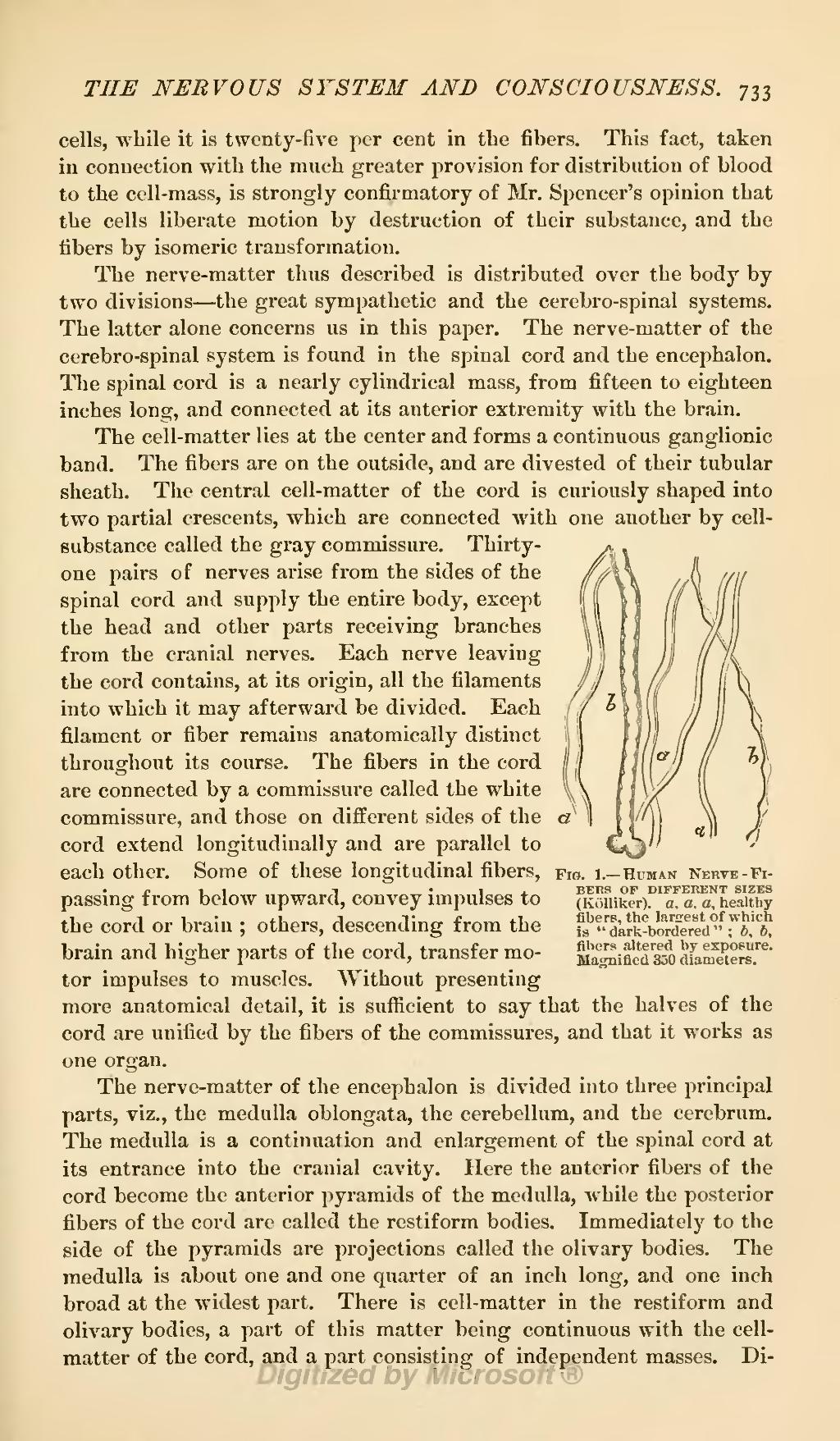cells, while it is twenty-five per cent in the fibers. This fact, taken in connection with the much greater provision for distribution of blood to the cell-mass, is strongly confirmatory of Mr. Spencer's opinion that the cells liberate motion by destruction of their substance, and the fibers by isomeric transformation.
The nerve-matter thus described is distributed over the body by two divisions—the great sympathetic and the cerebro-spinal systems. The latter alone concerns us in this paper. The nerve-matter of the cerebro-spinal system is found in the spinal cord and the encephalon. The spinal cord is a nearly cylindrical mass, from fifteen to eighteen inches long, and connected at its anterior extremity with the brain.
The cell-matter lies at the center and forms a continuous ganglionic band. The fibers are on the outside, and are divested of their tubular sheath. The central cell-matter of the cord is curiously shaped into two partial crescents, which are connected with one another by cell-substance called the gray commissure.  Fig. 1.—Human Nerve-Fibres of different sizes (Kölliker). a, a, a, healthy fibers the largest of which is "dark-bordered"; b, b, fibers altered by exposure. Magnified 350 diameters. Thirty-one pairs of nerves arise from the sides of the spinal cord and supply the entire body, except the head and other parts receiving branches from the cranial nerves. Each nerve leaving the cord contains, at its origin, all the filaments into which it may afterward be divided. Each filament or fiber remains anatomically distinct throughout its course. The fibers in the cord are connected by a commissure called the white commissure, and those on different sides of the cord extend longitudinally and are parallel to each other. Some of these longitudinal fibers, passing from below upward, convey impulses to the cord or brain; others, descending from the brain and higher parts of the cord, transfer motor impulses to muscles. Without presenting more anatomical detail, it is sufficient to say that the halves of the cord are unified by the fibers of the commissures, and that it works as one organ.
Fig. 1.—Human Nerve-Fibres of different sizes (Kölliker). a, a, a, healthy fibers the largest of which is "dark-bordered"; b, b, fibers altered by exposure. Magnified 350 diameters. Thirty-one pairs of nerves arise from the sides of the spinal cord and supply the entire body, except the head and other parts receiving branches from the cranial nerves. Each nerve leaving the cord contains, at its origin, all the filaments into which it may afterward be divided. Each filament or fiber remains anatomically distinct throughout its course. The fibers in the cord are connected by a commissure called the white commissure, and those on different sides of the cord extend longitudinally and are parallel to each other. Some of these longitudinal fibers, passing from below upward, convey impulses to the cord or brain; others, descending from the brain and higher parts of the cord, transfer motor impulses to muscles. Without presenting more anatomical detail, it is sufficient to say that the halves of the cord are unified by the fibers of the commissures, and that it works as one organ.
The nerve-matter of the encephalon is divided into three principal parts, viz., the medulla oblongata, the cerebellum, and the cerebrum. The medulla is a continuation and enlargement of the spinal cord at its entrance into the cranial cavity. Here the anterior fibers of the cord become the anterior pyramids of the medulla, while the posterior fibers of the cord are called the restiform bodies. Immediately to the side of the pyramids are projections called the olivary bodies. The medulla is about one and one quarter of an inch long, and one inch broad at the widest part. There is cell-matter in the restiform and olivary bodies, a part of this matter being continuous with the cell-matter of the cord, and a part consisting of independent masses. Di-
